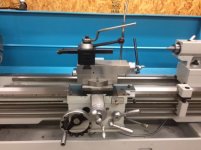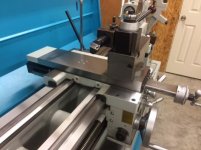rwskinner
Aluminum
- Joined
- Sep 22, 2015
- Location
- Somewhere in Texas
I bought a new Acra 21x60 and I have been using it a couple months. So far, everything has been going fairly well until I try to bore. All my bores are picking up tons of chatter even on light cuts. Using the same exact set up, feeds, speeds, and tooling my Leblond doesn't chatter at all. Feed and speeds are set up properly for the job as I do this same job on the Leblond on a regular basis.
Now, the Acra is cutting great in the outside turning, it's only the internal boring causing the issue. I checked the gibs on the cross slide and the compound and even have them locked to make sure they aren't too loose. I snugged up the gib on the front of the apron a tad tight to eliminate that area as well.
The job requires this 1.5" boring bar to be extended about 7" out from the holder. Most cuts are 0.050" from diameter or less in mild steel. Never a problem on the Leblond.
What all should I check? I put an indicator on the top of the apron and ways and check for excessive play then from the cross slide to the apron, then the compound to cross slide and I'm not showing any deflection (mainly because I have it all pretty tight right now).
Now on the back of the apron, I can pry it up off the ways about 0.004" so that needs to be tightened up some. I have to remove the back splash guard and take some time to adjust this out closer.
I put some 2" pipe in the 4 jaw chuck for leverage and put an indicator on the outside of the chuck. I am picking up about 0.002" on the outside of a 16" chuck but that is prying pretty hard. Is that too much? Parts are turning true and concentric so far.
Are the two items out of whack enough to cause all these problems? I've ran some pretty worn out iron over the years that never acted like this so I'm not real sure.
Ideas and help would be appreciated.
Richard
Now, the Acra is cutting great in the outside turning, it's only the internal boring causing the issue. I checked the gibs on the cross slide and the compound and even have them locked to make sure they aren't too loose. I snugged up the gib on the front of the apron a tad tight to eliminate that area as well.
The job requires this 1.5" boring bar to be extended about 7" out from the holder. Most cuts are 0.050" from diameter or less in mild steel. Never a problem on the Leblond.
What all should I check? I put an indicator on the top of the apron and ways and check for excessive play then from the cross slide to the apron, then the compound to cross slide and I'm not showing any deflection (mainly because I have it all pretty tight right now).
Now on the back of the apron, I can pry it up off the ways about 0.004" so that needs to be tightened up some. I have to remove the back splash guard and take some time to adjust this out closer.
I put some 2" pipe in the 4 jaw chuck for leverage and put an indicator on the outside of the chuck. I am picking up about 0.002" on the outside of a 16" chuck but that is prying pretty hard. Is that too much? Parts are turning true and concentric so far.
Are the two items out of whack enough to cause all these problems? I've ran some pretty worn out iron over the years that never acted like this so I'm not real sure.
Ideas and help would be appreciated.
Richard






